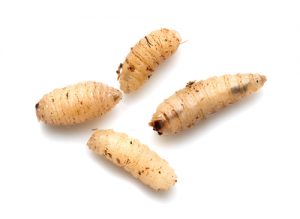My Maggots and Me!
By Chris Williams on March 20, 2012.
If you enter a hospital with an ulcerated skin wound, you just might end up with a doctor prescribing the application of fly maggots to clean out that wound! Fly larvae feed on rotting and decaying material, including human and animal flesh. Maggot therapy is a type of biotherapy that involves the introduction of live, sterile fly larvae (maggots) into non-healing skin and wounds for the purpose of cleaning out the dead tissue, a process called “debridement.” The maggots can consume necrotic (dead) tissues more precisely than a surgical knife can remove them.
In January 2004, the U.S. Food and Drug Administration (FDA) granted permission for the use of maggots as a prescription-only medical device for removing non-healing necrotic skin and soft tissue wounds. Today, maggot therapy is used in treatment of pressure ulcers, venous stasis ulcers, neuropathic food ulcers, and non-healing traumatic or post-surgical wounds. The wound must be a moist, oozing or pus-filled wound with a sufficient oxygen supply. Dry wounds are not suitable for maggot therapy.
This isn’t anything new. Maggots have been used since ancient times as a wound treatment. Napoleon’s general surgeon noticed that soldiers whose wounds had been invaded by maggots recovered better than soldiers whose wounds did not have maggots. They observed that the maggots ate only the dead tissue, did not touch healthy tissue, and therefore did a better job of cleaning the wound than anything else available.
Maggot therapy was common in U.S. hospitals before the discovery of penicillin offered a substitute treatment. Decades later as antibiotic-resistant bacteria became more of an issue, physicians began looking at maggots once again as an alternative treatment. Today, any physician in the U.S. can prescribe maggot therapy and over 800 health care centers use the therapy.
In one 2007 trial, maggots were used successfully to treat patients whose wounds were infected with MRSA, a bacterium that is resistant to most antibiotics, including methicillin. Some of these strains include the so-called flesh-eating bacteria that frequently cause death when deep tissue is infected. Maggots cleaned up the already dead tissue, preventing further spread of the infection.
So, just how do they do it? Maggot therapy is administered by means of a bag containing approximately 80 sterile blow fly maggots that feed on the wound surface through a polyvinyl alcohol membrane. The dressing must be air permeable or the maggots will die. The larvae move freely within the dressing and feed on the wound for two days. Some patients do report an uncomfortable tickling sensation and sometimes more pain at the wound site. At the end of two days, the then fully-grown maggots are removed. Multiple two-day courses may be administered depending on the severity and the healing of the wound. If the maggots are left on longer than two days or too many maggots are used, healthy tissue may be consumed as well.
More recent studies have not given such a great advantage to maggot therapy as first reported. In treatment of leg ulcers, maggot therapy was compared to standard hydrogel treatment (wet dressings that pull dead tissue from ulcers). The maggots did clear away the dead tissue faster but they did not speed healing of the wound. Maggots seem to have the advantage in certain situations requiring rapid cleaning of wounds, such as preparing patients for skin grafts where faster wound cleaning means patients can be moved into surgery sooner.